#construction equipment evolution
Explore tagged Tumblr posts
Text
The Backbone of Construction: A Deep Dive into Construction Equipment
When you pass by a construction site, what catches your eye? It’s not just the towering structures or the bustling workers; it’s the array of heavy machinery and equipment that makes the entire process possible. Construction equipment serves as the backbone of any construction project, enabling the realization of architectural marvels and infrastructural development. In this article, we will take…

View On WordPress
#advanced construction equipment#bulldozers#Construction Equipment#construction equipment automation#construction equipment evolution#construction equipment future#construction equipment safety#construction equipment significance#construction equipment trends#construction equipment types#construction industry#construction machinery#construction site equipment#Construction Technology#construction tools#construction vehicles#cranes#earthmoving equipment#environmental impact#equipment for construction#equipment types#excavators#heavy machinery#material handling equipment#precision machinery#Sustainable Construction
2 notes
·
View notes
Text
Engaging and Effective Safety Workshops and Seminars: Elevating Construction Safety Standards
Safety in the construction industry isn’t just a checkbox; it’s a foundational pillar that determines the well-being of every individual on a construction site. As the field witnesses rapid advancements, with novel construction methods emerging and state-of-the-art equipment being introduced, staying updated becomes non-negotiable. This dynamic landscape underscores the urgency for regular,…

View On WordPress
#Construction Industry Evolution#Construction Safety Training#Continuous Learning#Effective Seminars#Engaging Safety Workshops#Hands-on Safety Practices#Practical Safety Drills#Real-world Safety Scenarios#Safety Culture#safety equipment#safety excellence#Safety-first Mindset#Shared Safety Responsibility#Updated Safety Standards#Workshop Feedback
0 notes
Text
Arms and Armor of the Hallstatt Celts: A (not-so) Brief Overview
The Hallstatt culture is an archaeologically-defined material culture group. The typesite for this group is in Hallstatt, Austria, where a deep salt mine which had been in use since the Neolithic served as the lifeblood of the local community. A substantial cemetery of approximately 1,300 burials near the mine has helped to clearly define artistic trends associated with this cultural group. The culture is associated with early Celtic or proto-Celtic language speaking groups, and for a long time, was thought to have been the origin of the proto-celtic language. This idea has since been debunked, as it is now known the first proto-Celtic speakers predated the Hallstatt culture.
The Hallstatt culture is divided into four phases, A-D (henceforth abbreviated as Ha. A-D). The first two of these phases are associated with the end of the bronze age in the region, the last two, with the beginning of the iron age.

Since the defining of the culture in 1846, Hallstatt influence has been found from Eastern France to Hungary, as far south as Serbia and as far North as Poland. The core Hallstatt region covers much of Austria and Southern Germany. By the Ha. C period, distinct practices had arisen in the Hallstatt sphere of influence: distinct enough for academics to split the culture into two “zones”, the East and the West.

Unfortunately, due to the antiquity of this culture and the utter lack of any written records concerning them, the archaeological record is both relatively thin, and the only source of information available for these people. As such, in constructing a timeline of Hallstatt arms and armor, there will be substantial gaps which we can only hope will be filled by future discoveries.
Armor
Three types of armor are commonly found in Hallstatt contexts: belts, cuirasses, and helmets.
That broad belts (both of leather and of bronze) are considered armor in the ancient Mediterranean is clear from references in which these items are placed in context with other armor. In the Iliad, for example, in book 7 after Ajax and Hector meet on the field of battle and fight to a stalemate, they exchange equipment. Hector “gave over his silver-studded sword, bringing with it the sheath and well-cut baldric” (l. 303-304), while Ajax reciprocated with “his war-belt bright with crimson” (l. 305). Additionally, a short list of military equipment issued by the Neo-Assyrian empire recovered in Tel Halaf lists 10 leather belts alongside bows, swords, spears, and other arms and armor.
A number of bronze and gold belt plates survive from both the Eastern and Western zones, though most of these plates date to the Ha. D period.
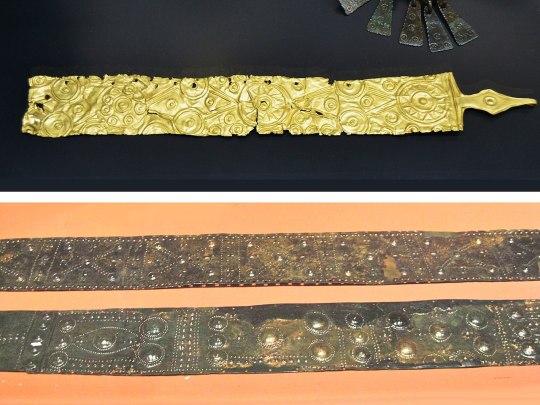
While the majority of these plates are decorated with embossed and incised geometric patterns, some (particularly from the Eastern zone) include scenes of warriors on foot and on horseback.
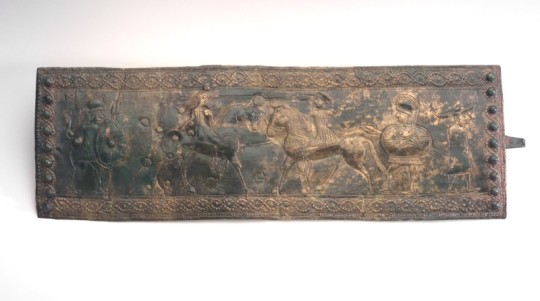
The cuirasses of the Hallstatt period exhibit an interesting progression. In their most basic form, these bronze cuirasses remain essentially the same from Ha. A-D. They are characterized by essentially simple forms: a tubular breast and backplate which terminates at the waist and includes a tall standing collar to defend the neck. The earliest examples, however, include substantial embossed decoration in much the same manner as appears on the belt plates.
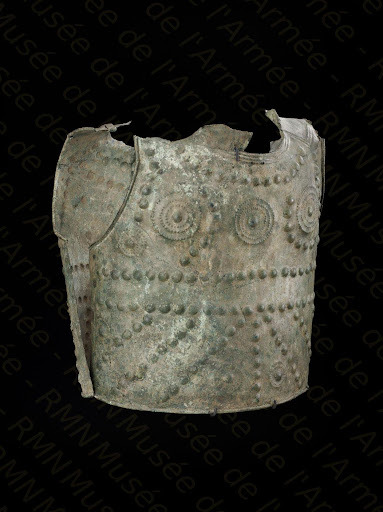
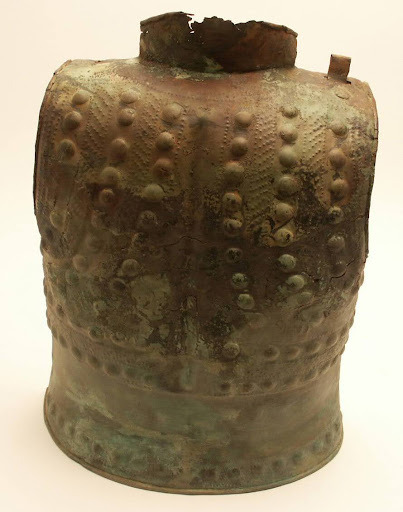
Only in the late Ha. B to early Ha. C period does this decoration begin to take on a more anatomical form; a group of seven cuirasses recovered in Marmesse, France in 1974 shows this evolution nicely. These cuirasses retain the same form, though a slight taper is now evident near the waist. The circular embossing closely resembles that of the previous period, however embossed lines are now apparent, and the placement of the embossing is such as to evoke the musculature of the warrior wearing it.
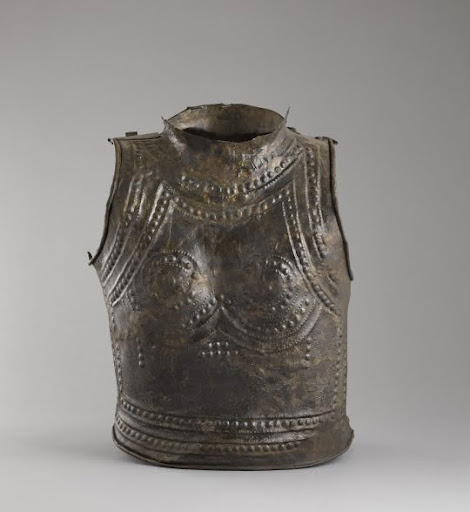

The final stage of the cuirasse’s evolution arrives in Ha. D. This form is much more plain, lacking the apparent horror vacui which typified earlier iterations of this style. Instead, the anatomical element is even more pronounced: embossing emphasizes the warrior’s pectoral and abdominal muscles, and additional circular bronze plates are riveted to the upper chest to simulate nipples.
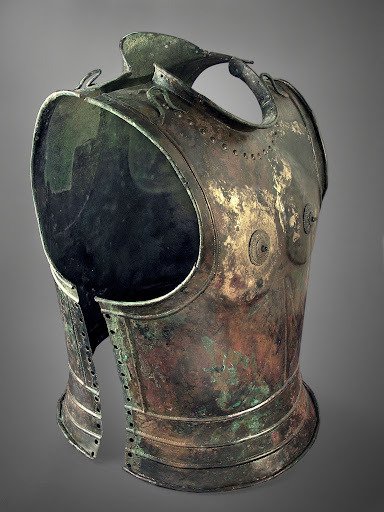
The final element of armor with substantial enough evidence in a Hallstatt context to be addressed is the helmet. Unfortunately, surviving helmets are extremely scarce, and there is no pictorial evidence to consult prior to the Ha. D period.
Four helmet types appear both archaeologically and artistically in Hallstatt contexts. We will call these the crested, the plated, the double-crested, and the Negau.
Only one artistic example of the crested helmet is to be found, and no archaeological examples. It is to be found on a grave good in the shape of a wagon adorned with many figures made ca. 600 BC and recovered in Strettweg, Austria.
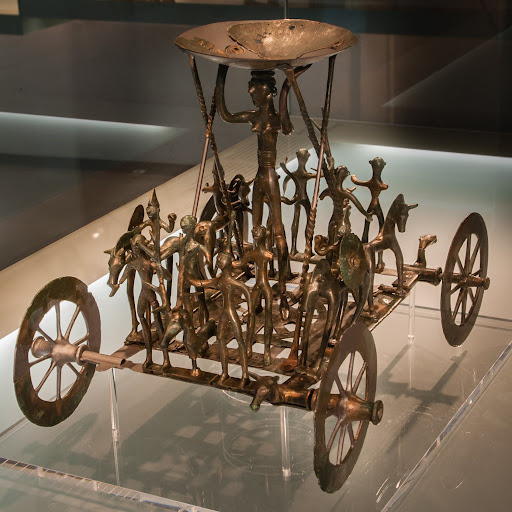
A find from Normandy (outside the Hallstatt sphere of influence) dated ca. 1200-700 BC shows what this type of helmet may have looked like.

The plated type is nearly as obscure, represented by only a single survival and a single artwork. The helmet, recovered in Šentvid, Slovenia and dated ca. 800-450 BC, is curious for the distinct pearly texture of its surface.
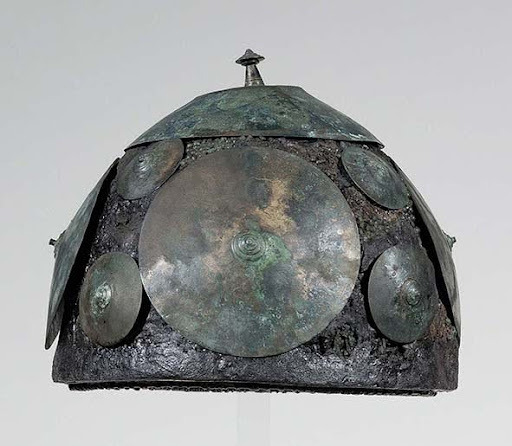
A number of similar helmets appear on a situla recovered from the Certosa Necropolis in modern Bologna, Italy. This situla is dated ca. 600 BC, and bears a striking resemblance to other situlae found in Hallstatt contexts.
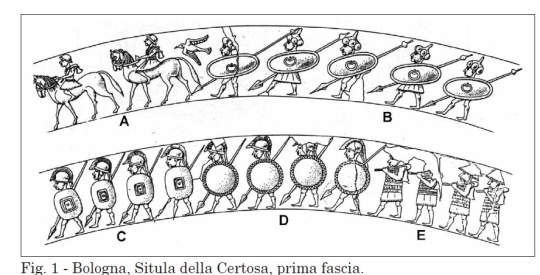
The most well attested form of Hallstatt helmet is the double-crested type. This type appears with the onset of Ha. D, and sees use until the end of the Hallstatt period. It is attested to by several survivals


and numerous depictions on a number of situlae
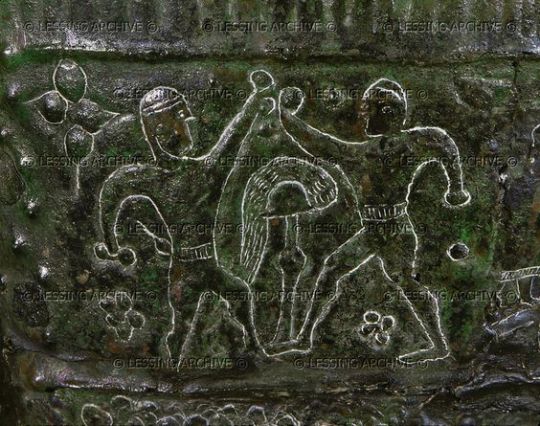
and belt plates.
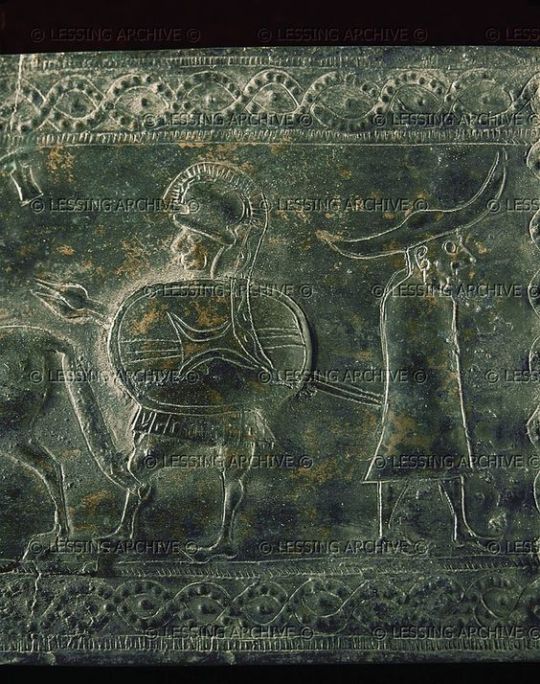
This type is so-called for the twin crests that adorn the helmet’s skull; crests which, as is attested by the pictorial evidence, served as anchors to large plumes likely made from horse hair.
The final type is named for a town in Slovenia where a large cache of helmets of this type was found in 1812. The Negau type appears at the very tail end of Ha. D, and primarily in Etruscan and Italic contexts. However a number of finds (including the eponymous horde) come from regions of Hallstatt (and eventually La Téne) influence.
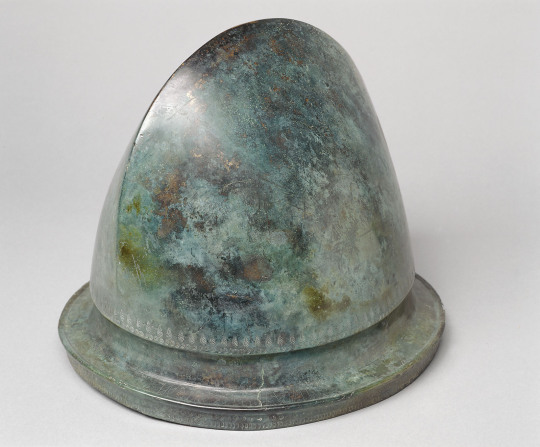
Weapons
The weapons which can be found in Hallstatt contexts are very much the same as those found elsewhere in Europe, consisting primarily on spears, axes, swords, and daggers. The spears and axes of the period are very similar to those found elsewhere in Europe and across the Mediterranean in the late bronze to early iron age, and as such will not be discussed further.


Indeed, even the swords of the Hallstatt bronze age (Ha. A-B) bear no significant differences from other swords found in Central and Western Europe at the time.
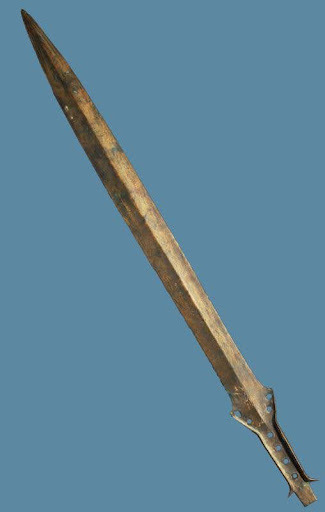
It is not until Ha. C, and the advent of the iron age, when two new types unique to the culture emerge. Though similar, these sword types, called Gündlingen
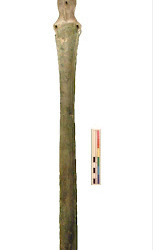
and Mindelheim, are distinguished by a number of factors.

First and foremost is size, with Mindelheim swords averaging around 85 cm or 33.5 in in length, while the Gündlingen type only averages 70-75 cm (27.5-29.5 in). Another striking feature of the Mindelheim type which is almost non-existent on Gündlingen swords is a pair of deep grooves on either side of the blade. Additionally, Gündlingen swords are only ever found in bronze, while Mindelheim can be found in either bronze or iron. Gündlingen swords seem to have been tremendously greater in popularity, with only 27 examples of the Mindelheim type being known to over 240 of the Gündlingen. There is also a geographical element: the majority of Mindelheim swords have been found in the east from Austria to Germany, Poland, and as far north as Sweden. Gündlingen swords, by contrast, have mostly been found in the west, as far as Britain and Ireland. Neither type, however, can be found in the core Hallstatt Regions after the advent of Ha. D, when daggers become the primary funerary good of the elite.
Daggers, of course, were not unknown in Hallstatt regions prior to 620 BC. A number of survivals from Ha. A-B attest to the fact that single-edged daggers were popular.

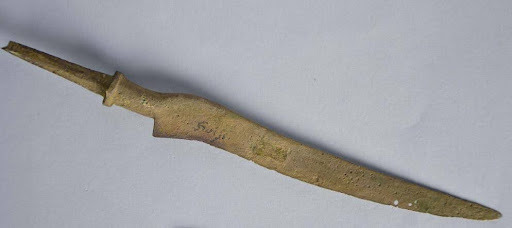
With the advent of the iron age and the rise in popularity of the peculiar Hallstatt sword types, daggers become more rare, until once again they spring back to the fore in Ha. D. At this time, a particular dagger type is almost ubiquitous. This dagger has long, straight quillons mirrored by a tubular pommel. The grip is thin, and the blade is broad and double-edged. This same basic form is present, both plain and with various embellishments, until the end of the Hallstatt period.

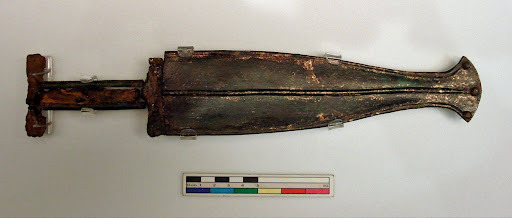
#arms and armor#weapons#armor#ancient history#hallstatt culture#celts#iron age#art#history#ancient celts#sword#axe#dagger#spear
148 notes
·
View notes
Text
The evolution of Inkopolis Square

Inkopolis Square is the central hub in Splatoon 2, also returning as one of the three hubs in Splatoon 3. It is a bustling center for Turf Wars activity in Inkopolis, but just how much has it changed over the years?
According to The Art of Splatoon 2, while Turf Wars action was centered around Inkopolis Plaza in the first game, the Square neighborhood used to be in a precarious condition, as it was "constantly dealing with minor crimes". Fortunately, it started undergoing redevelopment around the year 2015 (during/shortly after the events of Splatoon!)
By the year 2017, Inkopolis Square had new shops in its Galleria, along with the renovated Deca Tower and the Shoal, transforming it into the new hotspot for Turf Wars in the city. But the renovation did not stop there. when looking around the hub in Splatoon 2, it's possible to see a lot of construction equipment and materials laying around while large areas appear to be sectioned off.
It wasn't until its return in Splatoon 3 that we saw a fully overhauled Square. The skateboarding area has been completed, a lovely outdoors cafe was made and a brand new subway station was added. Overall, the whole area looks more welcoming and polished.

Great attention to detail and worldbuilding!
74 notes
·
View notes
Note
hi tsac!! can you tell us a bit about your observatory?? what kind of observation equipment do you control? what data do you collect? are there any other iterators you talk to that are similarly searching the stars for solutions to the problem? do you have a favorite astronomical formation?
So many questions! I will answer them in sequence.
Firstly, I control a number of different telescopes. Most of my telescopes are located on the roof of my can, but I also have several at ground level in the southern quadrant of my facility grounds. They each have different functions.

I have two optical telescopes at the top of my city’s observatory spire- these were primarily used by researchers to study specific objects, as they have a very narrow and detailed field of view.

The largest of my telescopes is my main survey telescope. This telescope has a very broad view and catalogues the positions of celestial objects across the entire sky every few nights. My survey telescope’s data comprise the vast majority of the pearls in my archives, and reduction of this data takes the longest.

On roof level I also have an array of radio dishes and microwave telescopes- these offer me a different view of the night sky than those offered by my optical telescopes, because they are able to detect different wavelengths of light.

There are about a dozen smaller optical observatories scattered throughout my city- these were primarily used by my citizens for teaching and recreational purposes. In their absence I have been using them for my own personal research.
Below my can, at the southern base of the mountain, are most of my radio telescopes. There are several arrays, as well as one large stationary radio dish located in the Temple Sector of my facility grounds. This section of my facility was primarily used by my citizens for ritual purposes- only the highest echelons of the clergy were allowed to approach the temple, meaning this area saw very little foot traffic and interference from radio communications. This allowed my nearby radio telescopes to sit undisturbed.

The array is far enough from my can to be mostly unaffected by the severe rain and snow I produce. The mountain peak also blocks most transmissions from the communications spire to the north, making the temple sector an ideal location for my main radio arrays. I still have to filter out the inevitable radio communications from my distant neighbors, though these signals are growing weaker over time….
Answering your second question about the data I collect: to put it simply, I collect… everything. Images, light curves, spectra, redshift and blueshift... the list goes on. My numerous telescopes generate vast amounts of raw stellar data, which then needs to be reduced and analyzed. After this process, if any trends stand out in the data, it is moved to my archives for further study.
My research focuses on changes in the night sky- monitoring the evolution of the celestial spheres was the primary reason for my construction. The stellar firmament is not static as those long ago believed- it is a living, changing thing. Such changes are hard to notice within the lifetimes of my benefactors, but become apparent on the timescales we iterators are familiar with. Perhaps studying the sky can reveal something about the Cycle. Maybe the Cycle, like the firmament, is not completely immutable.

@the-maddest-robot
I don’t have any space telescopes myself; my instruments are all ground-based. I only have direct access to the instruments located in and around my superstructure. However, there are some others within my field of study who do have space-based instruments. To name a few… Bright Crown, Habitually Stargazing, Quarks Untold, Hollow Intercession, Falling Space, All Mundane Order Towards Unawakened Discovery....
As for other astronomy-focused iterators… there are a few dozen others in my field of study. (This may seem like a large number, but it is a tiny fraction when compared to the demographics of the entire iterator population. My field is rather niche.)
Along with those I mentioned above, I am also familiar with the work of Twelve Endless Nights, Gazing Upon the Stars, Futile Persuit, A Gaze Into the Night Sky, and Firmament of No Stars, among others. We exchange data in our working groups occasionally. Though, I can't say I know any of them personally...
And finally... my favorite astronomical formation? I am quite fond of the constellation known as The Hunter. Within this constellation is a row of three bright stars, which according to mythology, are a string of pearls worn by the Hunter around their waist. These stars are referenced in a poem from the late Green hegemonic dynasty:
"...atop the mountain we saw the Hunter's glittering belt, three stars above clouds piercing the dark of the firmament aloft..."
This poem later became the basis for my own designation, Three Stars Above Clouds.
[ OOC: The iterators mentioned belong to, in order: @singularscissor , @kociamieta , @the-colossal , @enneegon , @overgrownmoon , @darkkeng , @charlie-jpeg , @luminumarashi , and @miikrowelle. I hope you don't mind; I wanted TSAC to mention other iterators in their field and I picked a few astronomy-related iterators that came to mind. Let me know if you don’t want to be mentioned and I’ll remove the tag. ]
#OOC: IF I FORGOT TO MENTION YOUR ASTRONOMY ITERATOR I'M VERY SORRYYYY ;_;#turns out there are actually a lot of them. I did not know this when I was conceptualizing tsac months ago lmao#this was a long one. yes I'm reusing some of my old art. I don't want to redraw all of those telescopes lol#communications manifest#three stars above clouds#iterator ask blog#iterator oc#rain world
46 notes
·
View notes
Text
If he does end up eating you, Bedelia, you'd have it coming.
I can't blame him for doing what evolution has equipped him to do.
If we just do whatever evolution equipped us to do, murder and cannibalism are morally acceptable.
They are acceptable to murderers and cannibals. And you.
Not just Will, but all of us are natural murderers and cannibals now? Thank you Bryan for the gaslighting.
Dialectics like mercy and murder, morality and immorality are all human constructs. None are human nature.
Hannibal never had God’s design on his side. On the contrary, he defies it.
22 notes
·
View notes
Text
Look, I'm not that much of an expert on Lethal League lore but-
I NEED TO KNOW MORE OF WHO "REX" IS (well; Reginald, Edgar and Xavier Saur as it's strongly implied to be 😑).
In the description for Raptor's DLC skin: Heavyduty R. Evolution, it somewhat tells the story of Raptor infiltrating Cybernetics, with Switch's help and discovering the truth of his grandfather(s?)
"In an attempt to find out more about his past, Raptor tracked a piece of Rex Works equipment back to Citynetics, Shine City's biggest construction company. After infiltrating the Citynetics factory with the help of Switch, he locked himself in one of the higher offices. Scrambling through some important documents, he noticed the names of the board directors. Reginald, Edgar and Xavier Saur. A loud bang erupted from the door. The guards had him cornered. Having lost his bat along the way, Raptor grabbed what gear he could find and mowed himself through the door. -Heavyduty R. Evolution"
And the first letters of their names make up the name 'Rex'. And if Raptor believed that he was the grandson of said 'Rex'...WHO. IS. THE REAL GRANDFATHER!?
And if that means Raptor has/had? Grand?Uncles? Does that mean he has cousins? Or maybe they're deceased?
It's never really mentioned how many fatalities occurred during the explosion, perhaps some family members and other unrelated survivors are still out there...possibly still trying to recover...
#original post#lethal league#lethal league blaze#llb#lethal league raptor#lethal league blaze raptor#llb raptor#lethal league rex#lethal league reginald saur#lethal league edgar saur#lethal league xavier saur
8 notes
·
View notes
Text
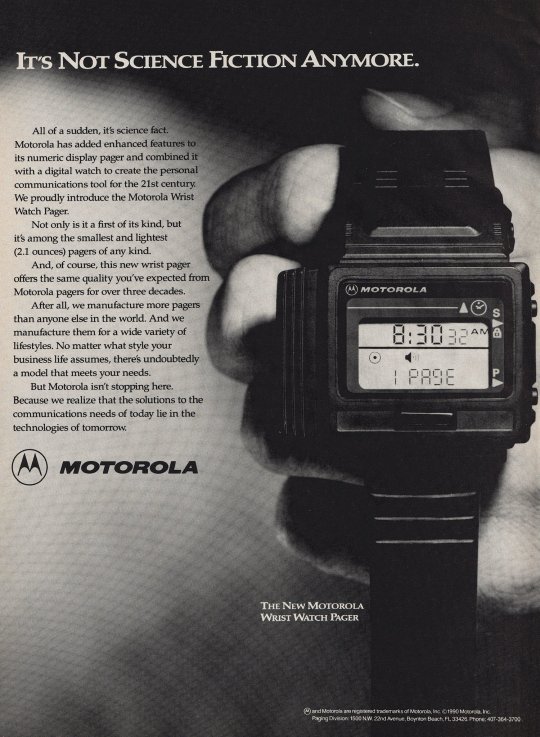
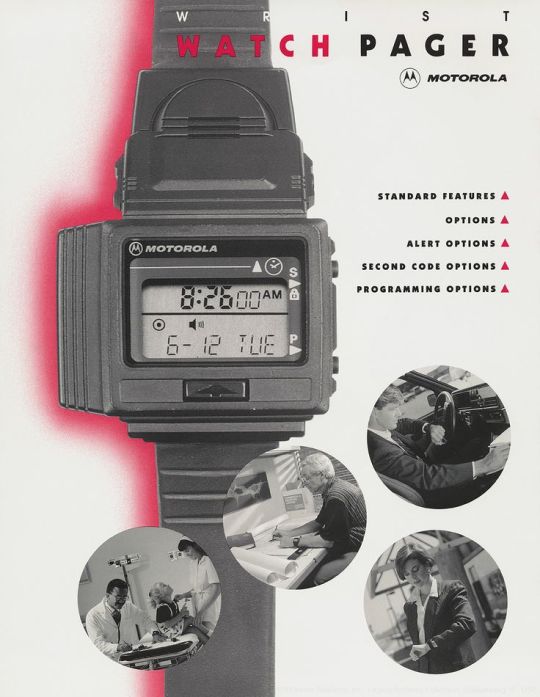

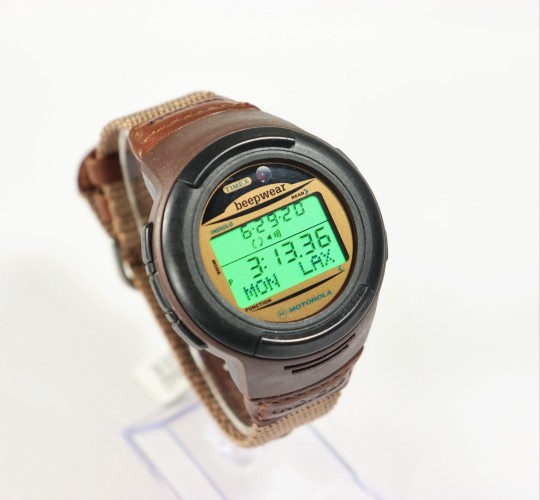
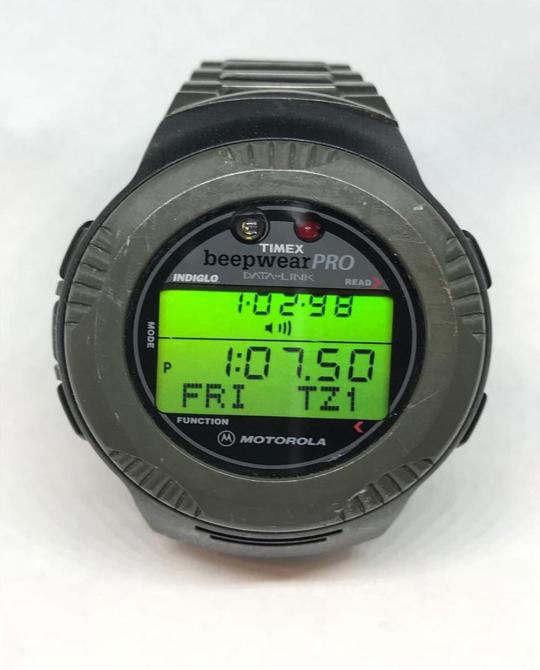
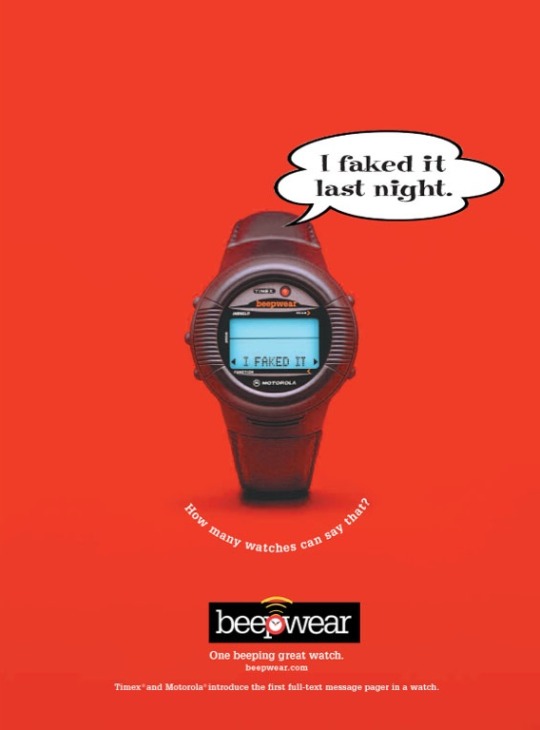
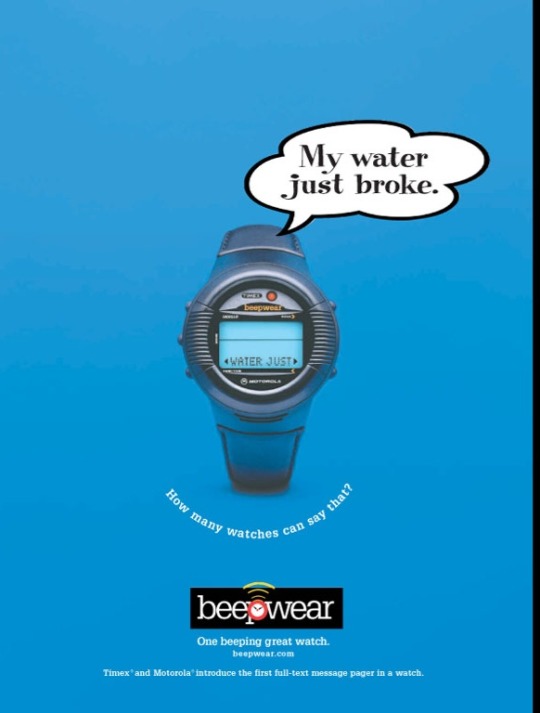
🇺🇲 Explore the Fascinating Fusion of Timekeeping and Communication: Unveiling the Pioneering Motorola and Timex Wristwatch-Pagers that Revolutionized Wearable Technology in the 1990s.
🤝 In 1990, Motorola Inc. made its first attempt to enter the market of electronic wristwatches with a built-in pager (similar devices at the same time were already produced by the Japanese companies Seiko and Casio). The device was called "Motorola Wrist Wach Pager". Since 1991, further production of the devices has been carried out jointly with the Timex Group Corporation under the name "The Timex Tracer Wrist Watch Pager".
👉 Since 1998, further development of the line of electronic watches with the participation of Motorola Inc. and Timex Group was associated with the high-tech "Timex Beepwear Datalink" series. These devices also continued the concept of wristwatch-pagers, but with the integration of the well-known Datalink data transmission platform, which integrates with desktop computer software.
➡️ The Datalink line was introduced in 1994 and was developed in conjunction with Microsoft Corporation as an alternative to conventional PDAs with added attributes such as water resistance and ease of programming. Taken together, all this made it possible to use the “Beepwear Datalink” watch as a full-fledged electronic organizer.
📟 The Beepwear Pager Watch epitomized the convergence of traditional wristwatches with cutting-edge communication capabilities. Introduced in the late 1990s, this innovative device redefined the concept of wearable tech, offering users unparalleled convenience and connectivity on the go.
📞 Equipped with pager functionality, the Beepwear Pager Watch allowed users to receive important notifications and messages directly on their wrist, eliminating the need for separate communication devices. With its sleek and compact design, it seamlessly integrated into everyday life, providing instant access to critical information wherever you went.
⌚️ Beyond its communication features, the Beepwear Pager Watch retained the timeless appeal of a classic timepiece, boasting a stylish and durable design that stood the test of time. With its reliable quartz movement and rugged construction, it was built to withstand the rigors of daily wear, ensuring longevity and reliability for its users.
⚙️ The "Beepware" series, as a joint product of the efforts of Timex Group and Motorola Inc. was patented, and the production of the devices was carried out by the newly created joint company "Beepwear Paging Products". The clock operated in the 900 MHz band. FLEX time was also used, which, if supported by the operator, could synchronize the clock time with the network time, and also automatically adjust to the owner's time zone.
🚀 The launch of the Timex Motorola Beepwear Pager Watch marked a significant milestone in the evolution of wearable technology, showcasing the potential for seamless integration of communication and timekeeping functions in a single device. As one of the pioneering products in this category, it paved the way for future innovations in the wearable tech industry, inspiring a new generation of smartwatches and wearable devices.
💔 However, already in 2002, Motorola Inc. was forced to carry out internal restructuring, including ceasing production and support of its own pagers.
💫 Today, the legacy of the Timex Motorola Beepwear Pager Watch lives on, remembered as a trailblazer in the realm of wearable technology. While newer devices may offer more advanced features, the Beepwear Pager Watch remains a symbol of innovation and ingenuity, reminding us of the transformative power of technology in shaping our lives.
#timetrek#brands#clock#watch#watches#time#companies#company#history#luxury watches#motorola#timex group#timex watches for men#timex#beepwear#pager#wristwatch#wrist watch#wristwatch pda#wristwatch pager#datalink#microsoft#smartwatch#digital watch#casio#seiko#made in usa#telecommunications#innovation#old gadgets
24 notes
·
View notes
Text

GAME: The Minish Cap DIRECTORY: Height ref, #character tag
A hero whose desire to save his best friend happened to include saving his world. The youngest member of the party, he's bold and curious to a fault. This can make him endearingly friendly to some — tactlessly pushy to others. As the Hero of the Minish, he places the magic of little kindnesses above all else and generally strives to echo the care he was shown on his journey as much as he can. This sometimes clashes with his fondness for mischief.

WEAPONS: Four Sword and Decorated Shield. Admittedly not the best swordsman of the party, but he has skills learnt from his grandpa and the Blade Brothers, and such experience with fighting against all odds that it would be ill-advised to underestimate him.
GEAR: Hero must-haves. With a family lineage of metalworking that he's very proud of behind him, he always carries around a set of tools that he deems necessary for the job. Ultimately arbitrary, but useful when on-field equipment maintenance is required! Beyond that and the items he's picked up over his hero's journey, his possessions clearly reflect his sentimentalities: his Pegasus Boots and Roc's Cape are well-loved, his Kinstone Bag has been patched up over and over, and he is never without Ezlo's hat.
SKILL: Magic user. Though he has a natural well of it, the Minish were his first real introduction to magic, so he doesn't have a very concrete idea of what to do with it. He can instinctively use catalysts like the Cane of Pacci without too much instruction required, but the only spell he knows how to cast is the one that will turn him into a Minish (literally).
SKILL: Smithing. While he still has things to learn from his grandpa, he is versed enough as a smithy apprentice that he can be trusted to evaluate, fix, or create quite a few things the party needs in the way of weapons, gear, and forged utilities. He's also vaguely familiar with Minish smithing and constructs, which he's found some Zonai devices strangely reminiscent of.

LANGUAGES & COMMUNICATION: Hearing. He only understands Hylian (Old Syllabary) while untransformed. In his Minish form — with the Jabber Nut's effects — he seems to understand all spoken language, including Minish, "animal-speak", and the more modern evolutions of Hylian. Non-speaking with limited literacy due to dyslexia, he primarily uses his era's Hylian Sign Language to communicate.
Makes an effort to stomp or clap to catch attention, but will sometimes fall back to initiating physical contact when he's tired and/or frustrated.
Will draw through any means available if his conversation partner doesn't understand HSL.
TRANSFORMATION: Without the presence of Minish Portals or Ezlo, shrinking down to Minish size comes with the side effect of turning Cori into a Minish himself. His aptitude for this spell is nowhere near refined enough to compensate for the lack of magical stability that would otherwise be offered.
PERSONAL TIMELINE: Went through the events of The Minish Cap when he was nine-years-old. It's been nearly a year since.
NICKNAME ORIGIN: Self-proposed from the word "Picori". Usually fingerspelled (syllabically, "Co-ri").


#linksconverge#links meet au#the legend of zelda#the minish cap#zelda au#lc cori#content / meta#'ray isn't his vector just from the height chart' yeah. shhh shh#feels unfinished...killing perfectionism is hard. but is good to try anyway. send post#overall layout very much inspired by the adven.turer's bible for dunm.eshi <3#queue tag.
8 notes
·
View notes
Note
I know this is asking too much from a series like black clover but I've been rereading the missing children arc and man I really wish we'd gotten some more insight into Neige's psyche. Like... sure he's soft and sweet, but let's not forget he got angry and struck Marie in rage because she OPPOSED HIM. He thought friends were just supposed to blindly agree his every word and immediately resorted to violence when frustrated. Which... I mean okay, it makes sense given that his only friends seemed to be his snowmen and that he was apparently raised by his brother who was verbally, emotionally AND physically abusive. But still! I wish we'd gotten to see his evolution beyond just "oh I was wrong to do all that, I'm going to be good from now on."
And let's not forget that he killed his brother??? He clearly cared about him despite everything??? Why are we brushing over all this???
Logically I know not every side character can get developed but still. Frustrating.
Sorry for the rant, I just needed to get this out and since I always enjoy your insights and you recently talked about the snow baby I thought you'd be the best person to go to. Have a nice evening!
Flamelet I can feel your frustration, and I know (to an extent) how it feels when your blorbo doesn't get the character development, or doesn't get it in a satisfying manner.
Also, don't worry about the rant! I'm all for hearing thoughts and feelings for the show, and the characters, as long as it's, y'know, constructively formulated. Which this is.
And for what it's worth, I think that Neige's emotional growth is stunted to some extent. Like, a lot of the behaviours he displayed, made me think of the word "tantrum", so he has never probably been taught how to handle his own emotions. (Like with striking Marie when she didn't just go along with things. Reminds me of toddlers pushing each other on a sandbox.) It's something that can be observed in people well into their 40s too, but usually it's displayed in other ways. But it's still the temper-tantrum phenomenon.
I would imagine that living with Baro would have caused a severe enough of a trauma for Neige to stay in that mind-set and emotional/psychological state. Defence mechanisms of a kind to not explore those emotions and or handle them in any way, and acting out of impulse. But also it could be a behaviour pattern that Neige learned from Baro. So, if Neige didn't go along Baro's plan, then Baro hit him, or something along those lines. And yes, though Baro did a lot of horrid things to Neige, Neige cared for Baro. Probably out of a "conviction" of a kind to an extent (like "I need to care for him because he's my brother"), but also probably because Baro was the only person Neige had in his life. And without his brother, Neige would have been all alone. And being alone is scary.
A lot of these events were a lot for Neige too, I would imagine, which could have placed him in a kind of a shock, where Baro's death wouldn't have visibly shown in that moment either. Maybe a form of denial? (I'm not a psychologist, so I'm just guessing a lot here) Which is why Neige wasn't shown grieving.
But also the "okay, I will be good from now on" is an intention, which I think would go well with someone who isn't yet equipped to handle emotions, especially complex emotions, at least well. So, without really reflecting on what happened and why; how things ended up where they did, Neige just blatantly decides "I will be good". The emotional growth, and learning the tools to handle his emotions and live without the ""guidance"" of Baro, come later.
Though, granted, as you mentioned, that a lot of this is just due to not being able to focus on every side character. So, this theorization "goes too deep", because things just needed to be wrapped up quickly, and Neige was given a very, very rushed redemption arc.
I really don't know, I'm just making a lot of (more or less) educated speculations ^^'
Thank you for the ask!
#black clover#black clover neige#anon flamelets#I'm so happy you like my little thoughts and insights!
13 notes
·
View notes
Text
Recent years have seen a surge in hammer-related injuries and fatalities, prompting scientists, medical experts, and researchers to investigate why this popular home and construction tool is proving so dangerous.
One line of inquiry has focused on the evolution of the hammer itself. It transpires that the basic design of the modern hammer is hundreds of years old, and therefore is severely under-regulated for the safety needs of modern users. This so-called “Reliance on Ego” effect can see heavy objects used with an outdated design that proves dangerous in delicate and hard to reach areas.
The reliance on ego can also be seen in the rise of the “modern” hammer designs. Compared to older designs, these often do not benefit from advanced ergonomics or innovations such as heat-treated steel that can better protect the user. As a result, many modern hammer designs are proving as dangerous as their ancestors, prompting further investigation into why this is.
In addition to the reliance on ego, experts have identified several other factors also contributing to the epidemic of hammer-related injuries. First is a lack of education on hammer safety. Proper safety gear is now widely available to reduce the potential harm of a hammer, but without basic training, such equipment can be easily overlooked or ignored.
Another factor has been identified as carelessness. The hammer is a very common tool, and as such, its use can be taken for granted to the point of carelessness. People often forget to pay attention while using a hammer, which can lead to injuries that are easily avoidable with the correct safety protocols.
Finally, cost-cutting measures taken by manufacturers can see them using cheaper, lower-grade steel or plastic instead of more robust materials. This not only reduces the lifespan of the hammer but also compromises its safety levels, making it more likely to chip, break, or cause a serious injury.
In conclusion, the causes of hammer-related injuries are many and varied. While some can be attributed to a reliance on ego, others are caused by a lack of education, unforeseen carelessness, or simple cost-saving measures. Whatever the cause, steps must be taken to prevent such injuries and ensure that this common tool remains safe for everyone.
2 notes
·
View notes
Note
Greetings Almighty Wizard! I am here to implore you again, could you maybe expand your quirk Tool Rule with costume, support gear, equipment, application, training and evolution, supermoves?? I have to say despite it being limited to simple tools, just the number of simple tools is already staggering! My mind is buzzing with applications but I wanna know what's on your mind for this Quirk.
So I won't be covering applications for this. I tried to come up with some, but it mostly boiled down to "user applies tool as weapon" or "user applies it like a normal tool". Those can cover a lot, but it quickly got repetitive when putting it into writing.
Training "Tool Rule" isn't that complicated. It's just going to involve the user moving the tools around, trying to increase their control over them, and working to divide their focus between their various implements. Maybe the user can learn some similar tricks from "Poltergeist", like using the various tools for flight. Otherwise, Support Gear is pretty easy as well. The only equipment the user needs are some supped-up tools, like simple tools made out of hyper-dense materials or razor-sharp machetes to deal as much damage as possible, all conveniently carried in a tool box or on their person. They even have easy costume inspiration by basing themselves on a handyman or construction worker. As for evolutions, the user could try to slowly expand what counts as a tool for them, like eventually controlling simple weapons like batons, as well as improving the range of their control, both in scope and in the number of tools they can manipulate at once. I think the most interesting would be the user expanding on their subconscious command of the tools, having them all working under their control to complete various tasks. Imagine a swarm of tools all working together to break apart or build something in rapid order.
10 notes
·
View notes
Text
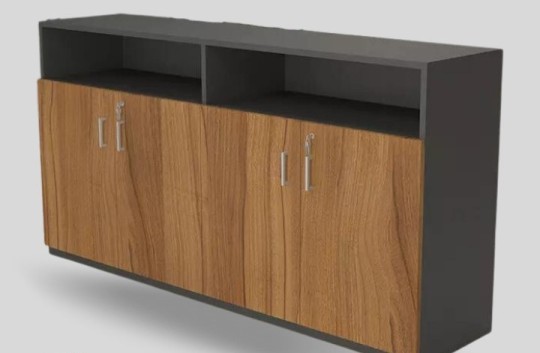
The Evolution of Office Storage: Cast Low Height Cabinet Trends
Iconic Office Furniture takes pride in introducing the Best Cast Low-Height Closed Doors Cabinet as an integral part of our premium office furniture collection. This sophisticated addition epitomizes our commitment to delivering top-tier office solutions that seamlessly merge functionality with elegance.
Our Cast Low-Height Closed Doors Cabinet is a testament to our commitment to excellence. Crafted from durable materials and equipped with lockable doors and soft-closing hinges, this cabinet guarantees longevity. Its versatile design allows you to utilize the top surface for small printers or decorative items, adding both functionality and style to your office.
Features That Make a Difference
Durable Construction: Constructed with the finest materials, ensuring a long-lasting investment for your office space.
Flexible Usage: Ideal for both open areas and manager rooms, providing additional storage solutions where needed most.
Customization Options: Choose from an array of board colors to tailor the cabinet to match your office's aesthetic seamlessly.
Display and Storage: The top open shelves offer the perfect opportunity to showcase items while optimizing storage.
Select from a Range of Surface Colour Premium options including White, Grey Bardolino Oak, Light Grey Chicago Concrete, Pacific Walnut, Natural Dijon Walnut, and Black Brown Thermo Oak. Additionally, you can choose from two different size Dimensions: 100 x 40 x 85 or 80 x 40 x 85, ensuring the perfect fit for your office layout.
Ease of Access and Quick Delivery
Our commitment to customer satisfaction includes standard delivery within 3 to 7 working days, ensuring your office can swiftly benefit from our premium furniture solutions.
Get in touch with us today for bespoke furniture customization or to request a free consultation with our expert team. Transform your workspace with personalized solutions tailored to your unique preferences and needs.
Contact Us Now to reimagine your office space with our exquisite range of modern and luxury office furniture.
#OfficeFurnitureDubai#LuxuryOfficeDesigns#ErgonomicSolutions#ModernOfficeFurniture#CustomOfficeFurniture#FurnishingsUAE#OfficeStorageSolutions
8 notes
·
View notes
Text


Enhancing Road Safety: The Lifesaving Power of Convex Mirrors, Barricades, Road Safety Gloves, and LED Solar Blinkers
Improving security through innovation: The evolution of product security:
Introduction: In the realm of road safety, every precaution matters. From highways to city streets, the potential for accidents and hazards is ever-present. In this blog post, Nevertheless, with the advent of innovative road safety products, we now have the opportunity to mitigate risks and save lives. we’ll delve into the lifesaving capabilities of four key road safety products like Convex Mirrors, Barricades, road safety gloves, and LED solar blinkers.
Convex Mirrors: Expanding Vision for Safer Roads Convex mirrors provide a wider field of view, particularly at blind spots and intersections, improving visibility for drivers, cyclists, and pedestrians to detect approaching vehicles and pedestrians from various angles. Blind spots are reduced and awareness is enhanced by convex mirrors, preventing the occurrence of accidents.
Barricades: Creating Safe Zones and Managing Traffic Barricades serve as essential tools for creating safe work zones, diverting traffic, and managing crowds during road construction, maintenance, or emergencies. Additionally, these barriers act as physical barriers, preventing vehicles and pedestrians from entering hazardous areas. Whether it’s redirecting traffic away from a construction site or delineating lanes during an event, barricades play an indispensable role in maintaining order and safety on the road.
Road Safety Gloves: Protecting Hands and Improving Visibility Specially designed road safety gloves offer protection and visibility for workers and cyclists, featuring reflective strips or high-visibility colors for enhanced visibility, even in low-light conditions. They also provide protection against abrasions, cuts, and impacts, reducing the risk of hand injuries.
LED Solar Blinkers: Enhancing Visibility and Signaling Self-contained, solar-powered devices equipped with LED lights that flash or blink to attract attention are LED solar blinkers. They are commonly used to mark hazards, delineate lanes, or provide warning signals to drivers and pedestrians. By enhancing visibility and signaling potential hazards, LED solar blinkers help reduce the risk of accidents, particularly in areas with poor lighting or visibility.
Conclusion: Innovation and technology are crucial for safer roads. Products like convex mirrors, barricades, safety gloves, and LED blinkers help save lives and prevent accidents. They expand vision, create safe zones, protect hands, and enhance visibility. Let’s prioritize road safety by embracing these innovative solutions for a safer future.
#road safety#convex mirrors#road safety gloves#LED solar blinkers#traffic safety#accident prevention#safety products#road safety equipment#road safety measures
2 notes
·
View notes
Text
Submitted via Google Form:
Can I make alien characters colour blind but not in the way humans or animals are but and also doesn't seem to make sense with what we know of vision? Like they mix up blue and green but can see reds and yellows. Maybe because they don't have rods and cones like we do.
Tex: Vision is a bio-mechanical system comprised of rods, cones, nerves, and other associated biological constructs, particularly in the human body (Wikipedia). Colour-blindness is typically genetic in cause and not an average design of eyesight (WIkipedia).
What is standard vision for one species can be unusual for another species, and this is something that is generally the product of niche environment evolution. If the species you’re worldbuilding inherently doesn’t have the ability to differentiate between blue and green, then that’s what their vision entails - it’s perfectly possible for their rods, cones, and whatnot to be arranged in such a way that different different parts of the visible light spectrum are processed as the same.
Licorice: It’s entirely up to you whether you want the species in your science fiction to follow the same biological principles as earth species, or do something partly or entirely different. You could equip them with some hitherto never-dreamt-of organ of sight. It would be a challenge, since we find it difficult to imagine things outside the scope of our experience, but it can be done.
Wootzel: Humans have three types of cones, and they’re relatively adaptable. We have red, green, and blue cones, but those can essentially detect a range of wavelengths, so we can perceive colors between those three. Our brains do some heavy lifting to determine 60% red light + 40% green light = a certain shade of orange, giving us a lot of precise color vision out of relatively simple eye “hardware.”
Plenty of animals--lots of birds and insects, among others--can see ultraviolet light, which has a shorter wavelength than what humans can see. Many birds have markings that can only be seen if you can detect ultraviolet, and lots of flowers have patterns that are invisible to us!
Some animals--certain species of snake come to mind, but I’m sure there are plenty of others--have the ability to “see” infrared, which is a longer wavelength than our visible spectrum. The examples I’m aware of don’t use their eyes to see infrared, but they have heat pits on the face. Infrared light/radiation behaves a little differently than visible light, in that it is… more or less a by-product of heat production, and snakes that can detect it generally use it to locate their warm-blooded prey.
Mantis shrimp are everyone’s favorite example nowadays of “look how weird nature can get with vision compared to humans,” so let’s talk about them a little.
Here’s an article that goes over some wacky aspects of mantis shrimp eyes, and here’s one that debunks part of what the other article says. The TL;DR of both of them is that mantis shrimp eyes have three to four times as many component types as human eyes, but their vision relies more on individual cones’ narrow spectrum sensitivity and less on their brains. This means that they can process lots of colors really quickly, but their actual ability to tell similar shades apart is quite a bit cruder than a human’s! They can also see ultraviolet, and curiously enough, they can detect the polarization of light. Here’s another article talking about how some animals use polarized light.
For one more wacky example of vision in nature, check out this explanation of how birds are theorized to literally see the Earth’s magnetic field to aid in migration.
Lastly, don’t forget about echolocation! Bouncing vibrations are a different strategy of “vision” that doesn’t use the same radiation as everything else I’ve mentioned.
Okay, so this is all just stuff found on Earth, and we may not have even discovered all the ways in which our animal neighbors can see the world differently than us (and for that matter, this is just all the stuff I’ve personally heard of). What would you like your aliens to perceive? Do you want to go about it in an entirely different way compared to Earth biology, or build from the same base? What about your aliens’ evolutionary environment might have made it advantageous to see certain parts of the spectrum more clearly than others, or make other parts irrelevant to them?
11 notes
·
View notes
Text
The History and Evolution of MIG Welding Technology
MIG welding, short for Metal Inert Gas welding, is a versatile and widely-used welding process that has significantly evolved since its inception. This blog explores the fascinating history of MIG welding, its technological advancements over the years, and its current prominence in the welding industry. We'll also touch upon the key equipment and accessories associated with MIG welding, including Everlast welders, ESAB welding helmets, argon tanks, and welding tables.
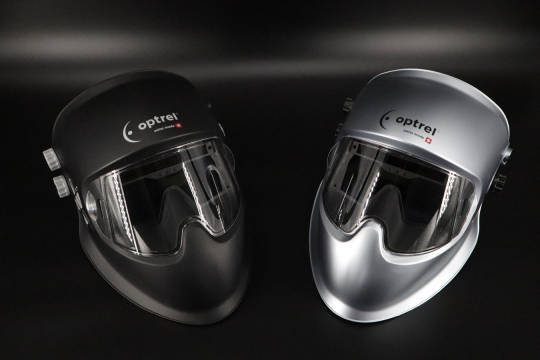
Early Beginnings: The Birth of MIG Welding
MIG welding was developed in the 1940s as a response to the need for a faster, more efficient welding method during World War II. It was originally known as Gas Metal Arc Welding (GMAW) and involved feeding a continuous spool of solid wire electrode through a welding gun, along with a shielding gas. The shielding gas, often argon or a mixture of argon and CO2 from an argon tank, protected the weld pool from atmospheric contamination, ensuring clean and strong welds.
Technological Advancements in MIG Welding
Early MIG welders relied on transformers and rectifiers for power. However, advancements in electronics led to the development of more efficient power sources, such as inverters, which allowed for greater control over welding parameters and improved energy efficiency. Everlast welders are known for their innovative power sources that cater to both amateur and professional welders.
The introduction of motorized wire feeders revolutionized Mig Welder by ensuring a steady and precise feed of the electrode wire. This innovation significantly enhanced the consistency and quality of welds, making MIG welding more accessible to a broader range of applications.
Welding tables became an essential component in MIG welding setups, providing a stable and ergonomic work surface. These tables, often made from sturdy materials like steel, provide a flat surface for positioning workpieces and securing them during welding. They play a crucial role in enhancing productivity and safety in welding environments.
ESAB welding helmets have evolved alongside MIG welding technology, offering improved protection, visibility, and comfort for welders. Modern ESAB welding helmets feature auto-darkening lenses that adjust to changing light conditions automatically, providing clear visibility of the weld pool while ensuring optimal eye protection.
Applications and Benefits of MIG Welding Today
MIG welding is renowned for its versatility, allowing welders to work with a wide range of materials, including steel, aluminum, stainless steel, and more. Its high deposition rate and ability to weld thicker materials make it ideal for various industries, from automotive and manufacturing to construction and repair.
With advancements in welding technology and equipment like Everlast welders and ESAB welding helmets, MIG welding has achieved unprecedented levels of precision and weld quality. Welders can achieve clean, aesthetically pleasing welds with minimal spatter, ensuring structural integrity and visual appeal.
MIG welding's efficiency and speed translate into cost savings for industries where time and labor are critical factors. The ability to weld continuously without frequent interruptions for electrode changes contributes to higher productivity and reduced downtime.
Looking ahead, the future of Everlast Welders technology continues to evolve with advancements in automation, robotics, and digitalization. Integrating artificial intelligence and machine learning into MIG welding processes promises further improvements in efficiency, quality control, and customization of weld parameters.
Conclusion
MIG welding has come a long way from its humble beginnings during World War II to become one of the most widely used and versatile welding processes today. Innovations in equipment such as Everlast welders, ESAB welding helmets, argon tanks, and welding tables have played a pivotal role in shaping the evolution of MIG welding technology. As technology continues to advance, MIG welding remains at the forefront of welding innovation, meeting the diverse needs of industries worldwide with its efficiency, versatility, and quality.
2 notes
·
View notes